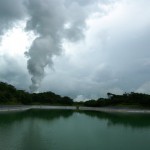There is a two-step process to crossing borders in Central America. First you have to “exit” the country you are in. If you are taking a vehicle through the border, that is an extra step. Then once you are free to go, you end up going through the “entry” into the next country just a few feet away and do it all over again.
We hoped to get a quick passage into Costa Rica, however our hopes were dashed as it soon became clear that we would be playing the waiting game for quite a while. We ate some local fare (beans, rice, plantains, meat), and as the waiting went on, we got more bored. While trying some fancy footwork with a soccer ball, I accidentally kicked the ax lashed to the front pannier of the bike, and it cut a deep gash into my combat boot. I franticly took off my boot to check for chopped off toes as my foot was in excruciating pain, but I was relieved to see all my toes intact. I keep this ax religiously sharp, and I only moved it out of the rear box 5 months ago to make more room for Cynthia’s stuff, hence it being mounted on the front box. People always made fun of it and thought that it was dangerous to have an ax exposed right up front, but I always replied: what idiot would possibly hit the ax?! and if it happened, he probably deserved it. That idiot turned out to be me!
The drive from the border to Liberia (not the country) was a nice drive. The roads started to improve and the rain was off and on. We stayed at a little hotel in Liberia and got killed by mosquitoes. Mosquitoes usually don’t like me, but Costa Rican mosquitoes were as friendly as they come. We tried to get some sleep, but the whizzing and the sharp stings didn’t help at all. At 5:30 a.m. another whizzing noise joined the choir. It was Cynthia swatting at mosquitoes while sitting in the bathroom, waving the little hairdryer aimlessly at my jeans, barely making any headway in taking the moisture out. It was time again to get up.
Costa Rica literally means the “Rich Coast,” and rightly so. It is the most expensive Central American country. It has two beautiful coasts, the Pacific Ocean to the west and south and the Caribbean Sea to the east. The middle is covered by some serious jungles, mountains and active volcanoes. We headed out to visit an impressive geothermal power plant in the countryside, next to the Miravalles Volcano. It lies between the two massive volcanoes, Poas and Barva, forming a wall to the north of the valley. Miravalles sits in the Guanacaste Province in the northwest part of the country, and if you can take your eyes off the extremely narrow and twisty road, you can see miles of coffee plantations in each direction on a clear day.
In a nutshell, how the geothermal plants work is that they extract the boiling underground waters and use the steam for running the electric turbines. To give you an idea, it’s kind of like tapping Old Faithful in Yellow Stone National Park to a steam generator. The environmental impact of the plant itself is minimal but building roads and getting there is what causes all the concerns. Since nine out of ten of best geothermal sites in Costa Rica sit in protected forests, there are no more expansions as of yet, but that could change with the next government. It’s interesting to note that the United States is the leader in geothermal electricity production with 3,086 MW of installed capacity from 77 power plants. The largest group of geothermal power plants in the world is located at The Geysers, a geothermal field in California.
We watched a powerpoint presentation and then got to tromp around through the lush vegetation in the rain to the lower hot springs. The water was boiling hot, and the steam that rose from it covered the whole area. In this lush and hot environment, every species has claimed a corner to itself, and they all live in harmony. From giant spiders to monkeys, Costa Rica has something exotic to offer to tourists. With all the advertising and National Geographic ads they put out every year, it’s not surprising to know that it is also the number one destination for tourists in Central America.
We were touring, but we weren’t tourists so we got back on the long road to San Jose, the capital of Costa Rica. The drive through winding one-lane roads on the hilly landscape was made even more challenging as night fell. The visibility was extremely poor, and we were going at about 30mph at best which was no fun. At one point, we passed massive car-sized boulders in the oncoming lane which had just fallen from the hills above us coming to rest partially on the highway, just at some houses’ doorsteps. Locals told us tragic stories about how people had been buried and never found again in rock avalanches, as well as swept away by the ground giving way from the massive rains. We were glad to make it to a dry place and have dinner before calling it a night.











